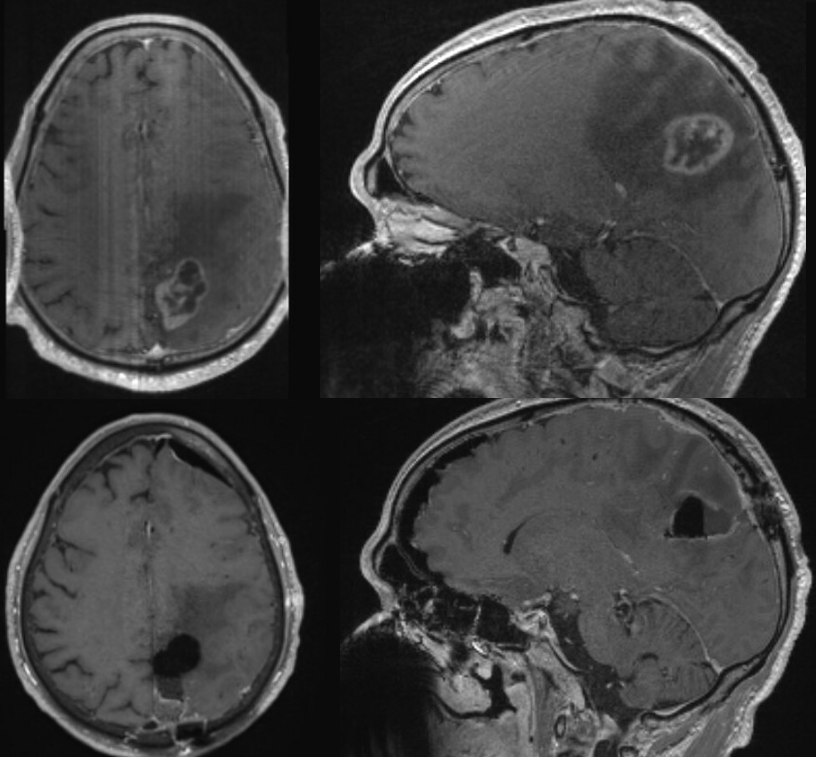Reviewed by Danielle Ellis, B.Sc.Apr 10 2023
Glioblastoma is the most prevalent kind of adult brain tumor. The disease is completely lethal, with no remedies, making it the most severe type of cancer. Because of the poor prognosis, researchers and neurosurgeons have been encouraged to better understand tumor biology to develop new therapies.
 An MRI showing glioblastoma pre- and post-operation. Image Credit: Dominique Higgins, MD, PhD
An MRI showing glioblastoma pre- and post-operation. Image Credit: Dominique Higgins, MD, PhD
Dominique Higgins, MD, PhD, an Assistant Professor of Neurosurgery, has accepted the challenge. Higgins and a team of Columbia University researchers discovered that glioblastoma tumor cells are more susceptible to ferroptosis, a kind of cell death that may be caused by removing certain amino acids from the diet.
First, we found that when we take away certain amino acids in animal models that the glioblastoma cells are more likely to die by ferroptosis. Secondly, we found that removing these amino acids makes our drugs a lot more effective at inducing ferroptosis in cancer cells.”
Dominique Higgins, Assistant Professor of Neurosurgery, Columbia University Medical Center
The observations were published in the journal Nature Communications.
Ferroptosis is a sort of iron-dependent “programmed cell death,” or a biological process in which cells “self-destruct” on command. Because human bodies do not need to kill cells unless absolutely required, the process is tightly regulated by biological systems. However, because ferroptosis was just discovered a decade ago, experts are only now beginning to understand the process.
The recent discovery of ferroptosis adds to the excitement of it all. It is really a rapidly growing body of research, and we are finding that it’s a very important for a lot of biological processes, and not just in cancers.”
Dominique Higgins, Assistant Professor of Neurosurgery, Columbia University Medical Center
Higgins is a member of the UNC Lineberger Comprehensive Cancer Center.
Every cell has specific safety measures that prevent it from undergoing ferroptosis in an unforeseen manner. Cysteine and methionine, two amino acids, are essential for preventing the process from commencing in cells. These amino acids are typically obtained from the diet.
Higgins and his research team chose to concentrate their efforts on these components.
They discovered that by limiting animal models of cysteine and methionine through a tailored diet, glioblastoma cells were substantially more likely to die by ferroptosis. They also discovered that the diet made their chemotherapy drugs more effective at inducing programmed cell death, which meant that very low doses may deliver a more potent effect than before. Finally, the animal models' survival improved when they went on the diet.
Now, we need to find a way to eliminate those components through dietary means, while still maintaining energetic requirements that a patient may have, especially a cancer patient, who has different requirements than the average patient.”
Dominique Higgins, Assistant Professor of Neurosurgery, Columbia University Medical Center
Higgins is collaborating with researchers at UNC Lineberger to establish a clinical trial for people with glioblastoma after demonstrating the diet’s efficacy in animal models. He intends to put patients on the diet before surgery in order to learn how it affects the body and the tumor. He will evaluate the tumor after removing it from the brain to see how well it reacted to the diet.
This treatment has also been demonstrated to be very beneficial in sarcoma, lung cancers, and pancreatic cancers, therefore, there is a possibility that this diet can be used to supplement chemotherapy and/or surgery to eradicate malignancies throughout the body.
Higgins is also collaborating with Shawn Hingtgen, Ph.D., Associate Professor of Neurosurgery and Professor of pharmacoengineering and molecular pharmaceutics at the UNC Eschelman School of Pharmacy.
Project Brainslice, a multi-institutional effort to test neurological therapies using tumor samples grown on slices of brain tissue, is led by Hingtgen. Higgins claimed that this method is superior to just observing treatment response in a plastic dish.
Project Brainslice is indeed one of the many research tools available to researchers at the University of North Carolina School of Medicine.
“We have a lot of different research tools unique to UNC, and it is one of the main reasons that I wanted to come to UNC. Just in terms of the ability to study a clinical problem in an accurate animal model, it is one of the few places in the country that has like an established setup to do that,” concludes Higgins, who joined UNC Neurosurgery in the fall of 2022.
Source:
Journal reference:
Upadhyayula, P. S., et al. (2023). Dietary restriction of cysteine and methionine sensitizes gliomas to ferroptosis and induces alterations in energetic metabolism. Nature Communications. https://doi.org/10.1038/s41467-023-36630-w.